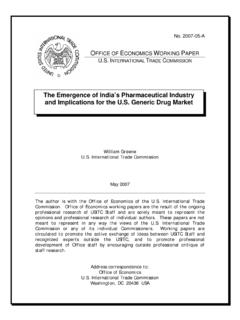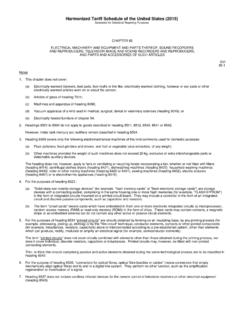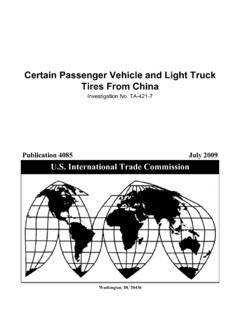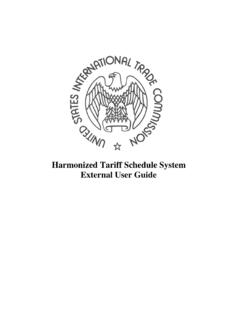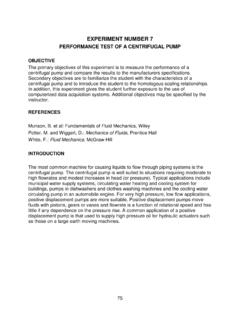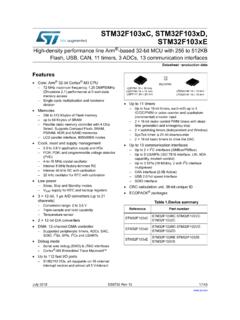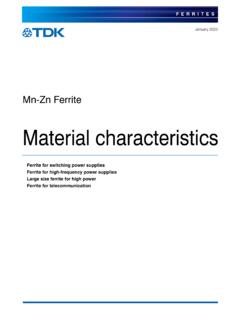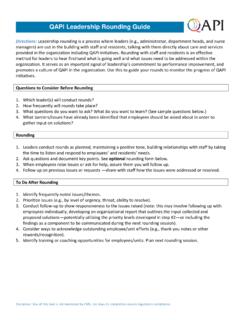Transcription of Small and Medium-Sized Enterprises: Characteristics and ...
1 United States International Trade CommissionInvestigation No. 332-510 USITC Publication 4189 November 2010 Small and Medium-Sized Enterprises: Characteristics and performance Address all communications to Secretary to the Commission United States International Trade Commission Washington, DC International Trade CommissionCOMMISSIONERS Deanna Tanner Okun, Chairman Charlotte R. Lane Daniel R. Pearson Shara L. Aranoff Irving A. Williamson Dean A. PinkertKaren LaneyActing Director of OperationsRobert B. KoopmanDirector of EconomicsRobert CarrActing Director Office of International Trade CommissionWashington, DC 20436 2010 Publication 4189 Small and Medium-Sized Enterprises: Characteristics and performance Investigation No. 332-510 This report was prepared principally by the Offices of Industries and Economics Co-Project Leaders William Deese and Erland Herfindahl Coordinating Project Leader Laura Bloodgood Principal Authors Tamar Asadurian, Michael Ferrantino, Eric Forden, Dennis Fravel, Tani Fukui, Joann Peterson, George Serletis, Jose Signoret, and Zhi Wang Primary Reviewers Joanna Bonarriva and William Powers Supervisory Reviewers Arona Butcher Special Assistance From Jared Fronk, William Greene, David Lundy, Cynthia Payne, Patricia M.
2 Thomas, and Jeremy Wise Under the Direction Of Hugh Arce, Chief Research Division, Office of Economics ABSTRACT This report is the third in a series by the International Trade Commission (USITC) that examines the domestic and global operations of Small and Medium-Sized enterprises (SMEs). The Commission found that exporting SMEs outperform their nonexporting SME counterparts by several measures. Whether they deal in services or manufacturing, exporting SMEs show higher total revenues, faster total revenue growth, and higher labor productivity than their nonexporting SME counterparts. The Commission also found several noteworthy contrasts between exporting large firms and exporting SMEs. Across all sectors, large firms primarily sell to foreign clients via foreign affiliates rather than through direct exports, while SMEs serve foreign clients primarily through direct exports.
3 Exporting services SMEs, which represent a very Small share of all services SMEs, are more export-intensive than large services exporters. services SME multinational companies, which are even less common, are nearly three times more export-intensive than large multinationals. On the other hand, trade barriers, including both tariffs and nontariff measures, disproportionately affect SMEs relative to large firms, as do many business impediments, such as high transportation costs. In addition to their role as direct exporters, goods and services SMEs also participate in the export economy by exporting indirectly through wholesalers and other intermediaries or selling intermediate goods or services domestically to large and Small firms that use these intermediate inputs to produce exported goods or services.
4 The Commission estimates that SMEs contribute a substantially higher share of the value-added content embedded in exports than suggested by traditional trade statistics. i iii CONTENTS iList of Frequently Used Terms and Acronyms ixExecutive xiChapter 1: 1-1 Purpose and scope .. 1-1 Approach .. 1-2 Data sources .. 1-2 Statistics on SME trade and foreign affiliate sales .. 1-3 Commission survey of 1-3 Other sources of data .. 1-5 Organization of the 1-5 Previous reports in this series .. 1-6 Chapter 2: Exports and SME 2-1 Key findings .. 2-1 Size and performance .. 2-1 Exporting and performance of manufacturing 2-2 Exporting and performance of SMEs in the services 2-4 Chapter 3: Examination of Services SME 3-1 Key findings.
5 3-1 Tradable services .. 3-2 Cross-border trade .. 3-3 Top five services subsectors .. 3-3 Services SME share of exports and 3-6 SME exporters 3-7 Sectoral analysis .. 3-7 Services supplied through 3-13 SME MNCs share of parent 3-13 Services SME MNC s foreign sales growth .. 3-16 Foreign affiliate 3-17 Foreign affiliate sales concentrated in foreign markets .. 3-21 Data gaps on SME exports of services .. 3-21 Bureau of Economic Analysis .. 3-21 Census Bureau .. 3-23 Approaches for overcoming data deficiencies .. 3-23 Potential improvements.
6 3-23 Comparison to other countries best 3-24 iv CONTENTS Continued Page Chapter 4: SMEs Multinational 4-1 Key findings .. 4-1 SMEs as MNCs .. 4-2 SME MNCs: 4-4 Foreign affiliates of SME MNCs .. 4-4 Foreign sales by SME MNCs .. 4-6 Goods exports by SME MNCs .. 4-6 SME MNC labor productivity .. 4-7 SME MNCs by 4-9 Firm size and methods of serving foreign customers .. 4-9 Related-party exports of SMEs .. 4-13 Small and Medium-Sized affiliates of foreign enterprises .. 4-15 Chapter 5: Indirect exports of 5-1 Key findings .. 5-1 Indirect value-added exports by 5-2 Conventional export measures and an alternate 5-2 Indirect SME value-added exports.
7 5-4 SME indirect exports via wholesalers and other intermediaries .. 5-7 The role of wholesalers and other intermediaries .. 5-8 Indirect SME exporters by sector .. 5-14 Indirect SME agricultural exports .. 5-14 Indirect SME manufacturing exports .. 5-18 Indirect SME services 5-19 Chapter 6: Trade Barriers that Disproportionately Affect SME Export 6-1 Key findings .. 6-1 Disproportionate impediments to SME exports .. 6-1 Most frequently encountered 6-2 Highest ranked 6-8 Impediments disproportionately affecting SMEs.
8 6-10 Experience and the severity of 6-13 Tariffs faced by 6-15 Tariffs faced by different 6-15 Firms perceptions of foreign tariff barriers .. 6-17 Nontariff measures .. 6-18 Examination of specific NTMs .. 6-20 NTMs facing SME 6-21 Barriers to foreign markets in services industries .. 6-23 v CONTENTS Continued Biblio-1 Appendices A. Request letter ..A-1B. Federal Register notices ..B-1C. List of industries covered in datasets ..C-1D. Additional chapters 3 and 4 tables ..D-1E. Business Firm Questionnaire ..E-1F. Description of USITC questionnaire methodology ..F-1G. Discussion of firm Characteristics based on questionnaire results.
9 G-1H. The indirect contribution of SMEs to exports: Conceptual model and estimation .. method ..H-1 Boxes Marketing methods to foreign clients .. Born global SMEs acquired by foreign MNCs .. Variable and fixed costs of exporting .. Impediments to exporting experienced by minority-owned businesses .. Foreign barriers to SME agricultural exports .. Export-import bank trade finance products for SME services Figures Services: Shares of SMEs and large firms rating impediments as burdensome (response of 4 or 5 on scale of 1 5) .. Manufacturing: Shares of SMEs and large firms rating impediments as burdensome (response of 4 or 5 on scale of 1 5) .. Manufacturing SMEs that export have higher average revenue per firm than manufacturing SMEs that do not Portfolio management firms are the largest SME exporters: SME and large services firms export revenue, top five subsectors, 2007.
10 No one SME size class dominates export revenue: SMEs and large services firms shares of export revenue, with SME s share broken down by number of employees, 2007 .. Services SME exporters account for a Small share of service sector employees: All services establishments, share of total services employees, 2007 .. Services SMEs exporters outperform large services exporting firms: SMEs and large services firms growth rates, 2002 07 .. SME services MNCs are more export-oriented than large services MNCs: Ratio of foreign sales to total sales by MNCs, 2007 .. SME parents in Other service industries have highest foreign affiliates sales: Distribution of foreign affiliate sales in service sectors, 2007 .. Foreign affiliates of services MNCs rarely service clients in the United States: Foreign affiliate sales in service industries by destination, 2007.
